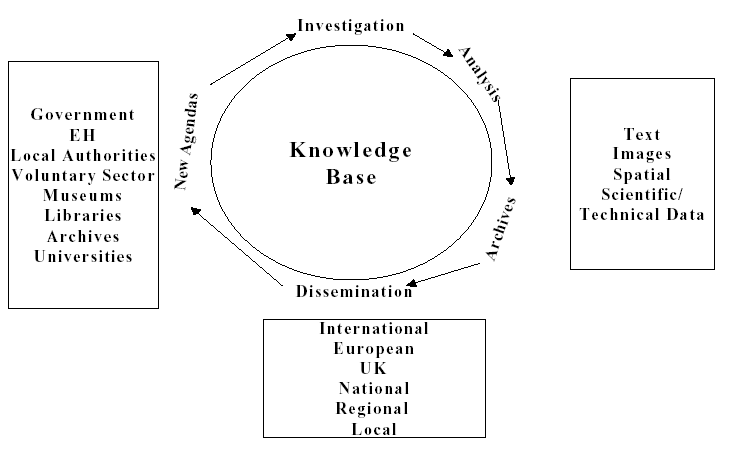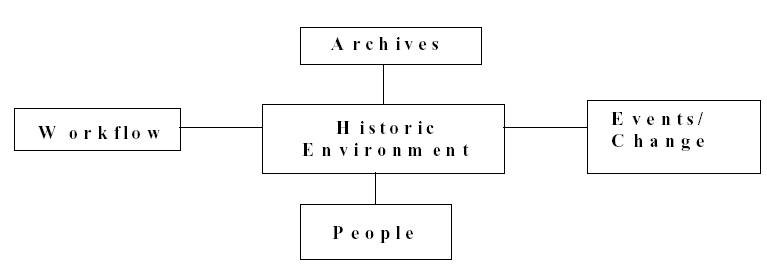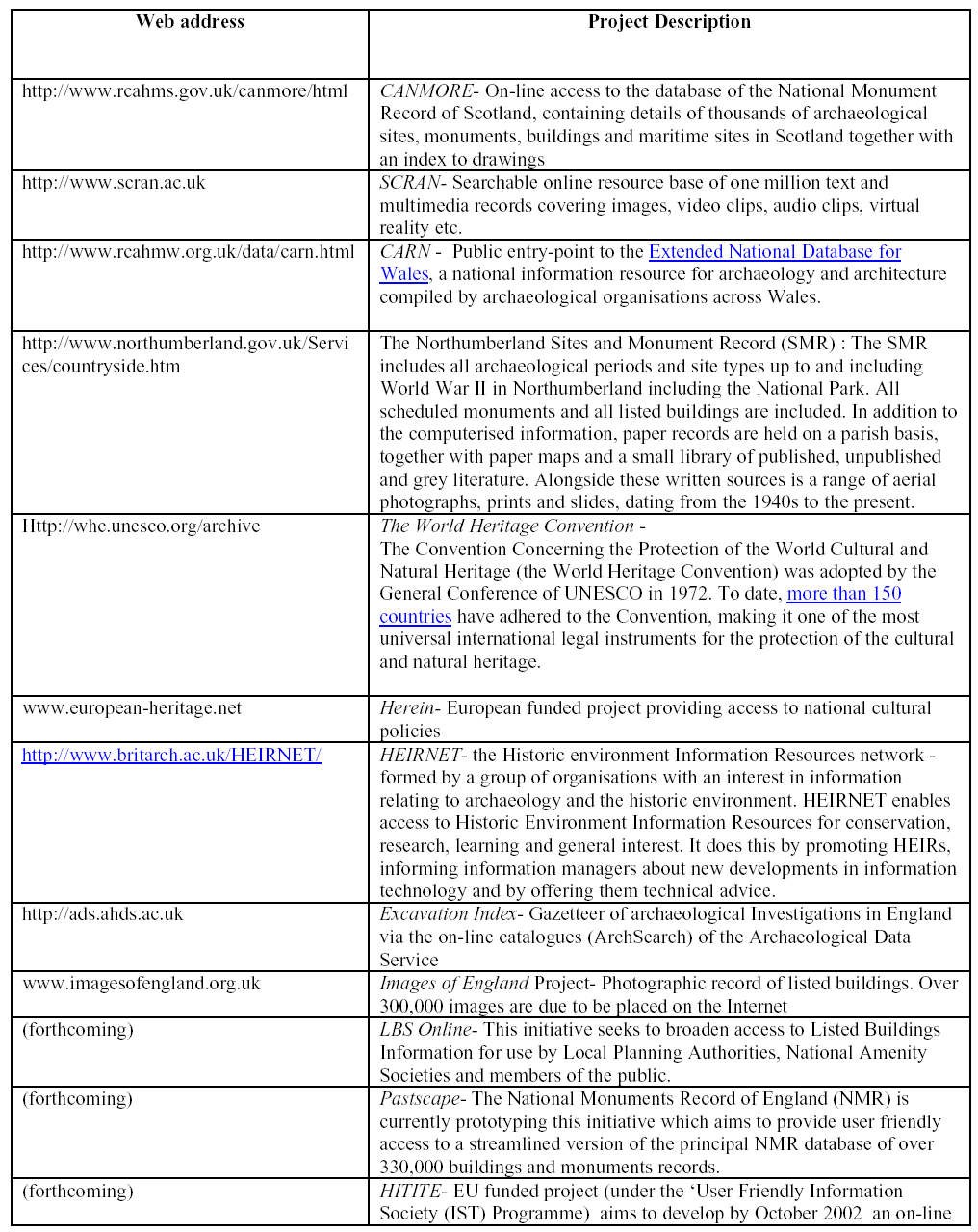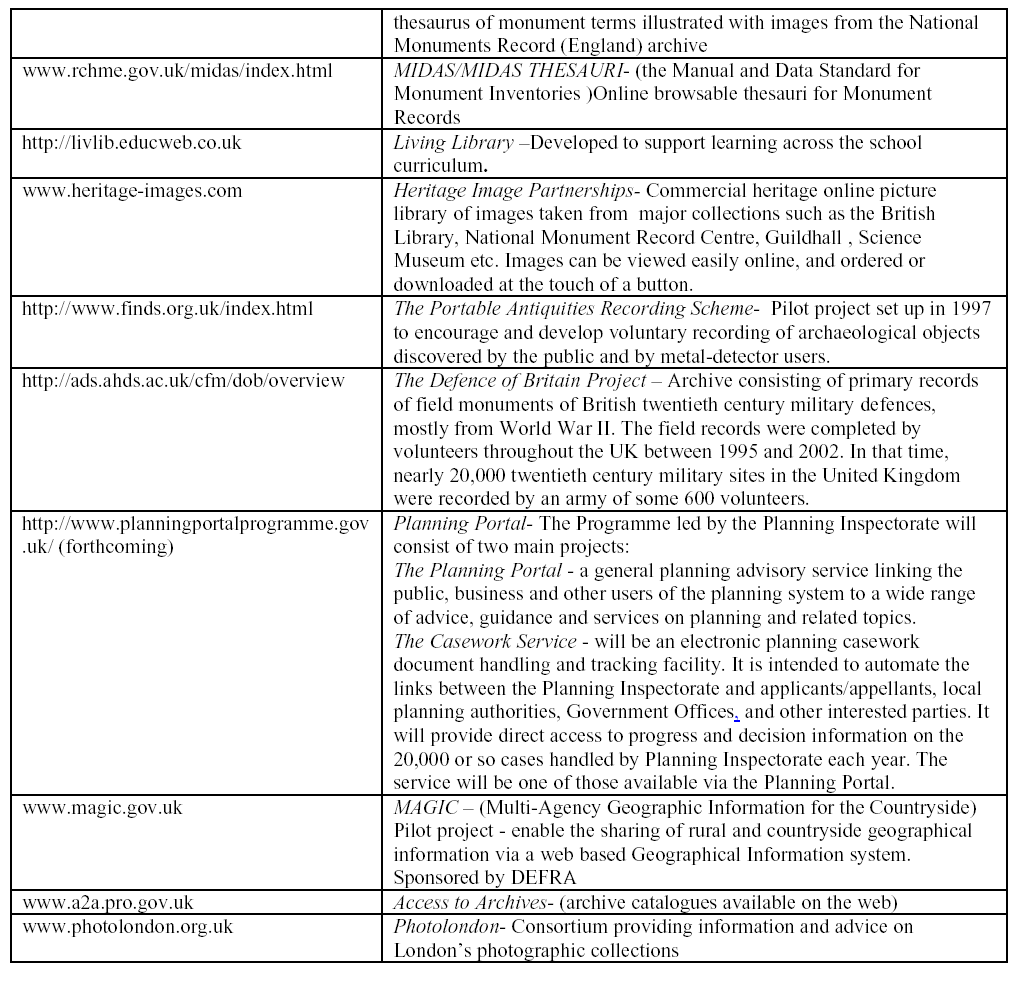
1
Planning and the Historic Environment 2002
An Agenda for the 21
st century – 17 May 2002Information flows in the digital age
Nigel Clubb
National Monuments Record, English Heritage
The desire to identify, record, understand, explain and enjoy the heritage of our historic
sites, monuments and landscapes is characteristic of a society which values its history and
culture. The capture of information about the historic environment, through archaeological
and architectural survey and investigation, and the dissemination of information and
interpretation, is central to this desire. Information about the historic environment should
be available to all, both specialists and the public. The potential in the digital age is for
survey data and information to flow electronically from its creation to the archive and to
the end-user through Internet access. There is also the potential to encourage new groups
within the community to engage with the historic environment, based on participation and
social inclusion, as well as curriculum needs. While current developments in England are
encouraging, the general picture looks patchy. The capture, storage and dissemination of
historic environment information is fragmented and under-resourced. Only a strategic
framework which includes all the key players and voluntary and commercial sectors will
make integrated and virtual access a reality.
The knowledge base
Our understanding of the historic environment rests on the knowledge base, (see Fig 1).
This base is enhanced through investigation and analysis which themselves create new
archives and enhanced material for dissemination and set new agendas for further work in a
on-going cycle. There are a large number of players including government, English
Heritage, the Heritage Lottery Fund, resource, local government, archaeological units,
museums, archives, libraries and universities. Other sectors, the educational and
environmental also have a part to play, as do voluntary and commercial interests. There is
also a hierarchy of levels, from the local, through the regional, national, UK and European
to the international. The material is varied, including text, images, spatial and
scientific/technical data. Much of it is now captured electronically, for example, as wordprocessed
files, digital imagery, or through electronic distance measuring and global
positioning techniques.

Fig 1 – The knowledge Base
The data model for the historic environment is necessary complex, (see Fig 2). There is a
requirement to model change from the past through to the present and future, based on
primary archives and the people associated with the historic environment. There are
demands for the casework and advisory services associated with the historic environment to
be automated and delivered electronically on grounds of efficiency, as well as to meet
government targets for the delivery of modern services.

Fig 2 – Simplified data model
Some current dissemination initiatives
Although this paper focuses on England, there are good models to be found in Scotland and
Wales.
CANMORE provides on-line access to the database of the National MonumentsRecord of Scotland, (for details of the websites mentioned in the text see the appendix to
this paper). Also in Scotland,
SCRAN provides access to resources from a number ofScottish cultural institutions. In Wales,
CARN provides access to the resources of theNational Monuments Record together with other archaeological institutions across Wales.
In England, a handful of local authority Sites and Monuments Records (SMRs) or Historic
Environment Records (HERs), are on-line, or planning to be on-line, often encouraged by
lottery funding. The Northumberland SMR is an example of this.
At a global level, details of World Heritage Sites are available on the web. There is also the
EUROPEAN HERTAGE.NET project, which provides access to the cultural heritage
policies of the countries associated with the Council of Europe. At UK level,
HEIRNETprovides a register of digital resources, while its sister project
HEIRPORT, shows how aportal may be developed to provide access to the resources of several institutions. The
ARCHAEOLOGY DATA SERVICE has made a major contribution to providing access to
digital resources, such as the Excavation Index of the English Heritage National
Monuments Record, and to the promotion of standards for interoperability and digital
archiving.
English Heritage has a number of on-going and forthcoming projects, including
IMAGESOF ENGAND, (which has incidentally generated perceptions of security risks from
providing details of property on the web, in this case, photographs of listed buildings,
including private dwellings).
LBS ONLINE will make available the statutory record oflisted buildings to local authorities and the statutory amenity societies later this year and to
the public next year. Also later this year,
PASTSCAPE will provide access to the mainNational Monuments Record database, using a prototype interface designed with intelligent
12-year olds as the target audience. English Heritage has also been active in providing web
access to data standards and thesauri for monument inventories, (see the appendix to this
paper).
PHOTOLONDON is a partnership between public institutions with Londonphotographic resources. The English Heritage National Monuments Record has also
provided selected resources for dissemination by commercial networks with expertise in
particular markets, for example the
LIVING LIBRARY for education and the HERITAGEIMAGE PARTNERSHIP for picture researchers.
There are a number of other types of access initiatives; the
DEFENCE OF BRITAIN is anexample of a large number of thematic databases being developed in the voluntary sector,
while the
PORTABLE ANTIQUITIES recording scheme represents the interface betweenthe historic environment and museum sectors. The
ACCESS TO ARCHIVES (A2A) projectprovides access to archives catalogues and the National Monuments Record plans to join
the project later this year. There are also important developments in related sectors, such as
the
PLANNING PORTAL, providing both the knowledge base for planning as well asadvisory and casework services and
MAGIC, which will enable the sharing of rural andcountryside spatial information via a web-enabled geographical information system.
Issues
The historic environment sector in England is relatively fragmented for its size, for
example, there are around 100 local SMRs or HERs. Traditionally, there have been
compiled and maintained by archaeologists and many are not fully integrated into the
historic buildings conservation framework. Indeed, there is some way to go before the
knowledge base represents the holistic historic environment. It is suggested that the sector
should look at the further development of portals to provide more integrated access to its
information resources, portals which should be closely linked to related developments, such
as the Planning Portal and Culture Online, if that project is funded by government. Perhaps
there should be two complementary initiatives:
- for specialists, a portal and network which provides seamless access to information
and archives resources, mapping across to annual state of the historic environment
audits and OS digital products, as well as online advisory and casework services
- for public, access to information and archives resources, supported by interpretation
and virtual experiences of the past. This will encourage new groups within the
community to become engaged with the historic environment based on participation
and social inclusion as well as curriculum needs.
While the provision of seamless access to the knowledge base is critical and is probably the
easiest issue to resource, there are host of related issues which the sector needs to address
together. These include:
- Understanding the user / customer base
- Developing business cases and justifications for funding
- Roles and responsibilities of partners
- Analysing the work processes which are supported by the knowledge base or create it
- Standards
- Backlogs in data capture and cataloguing
- How best to present the story of the historic environment from prehistory to present
and future
- How best to apply the interactive technology being developed elsewhere
- How to acquire and harness commercial and marketing skills
Standards present a whole range of issues: technical, systems, data structure/models and
terminology as well as how to apply and integrate specialist data categories such as images
and spatial data. Standards for interoperability need to be decided and applied by the whole
sector, such as:
- the Z39.50 international standard maintained by the Library of Congress, which
specifies a client-based protocol for security and retrieving information from remote
databases without imposing universal data standards
- the Dublin core standard for interoperable online metadata standards.
Conclusion
It is clear that increasingly the capture, storage, management and dissemination of historic
environment information will be digital. It is also clear that a relatively fragmented sector
must work together to ensure the efficient use of scarce resources and to avoid duplication
and overlap. There needs to be a quantum shift in England towards exploiting the internet
as the single most powerful tool for access to archives and the dissemination of knowledge.
Web-enablement has the potential to deliver tailored and integrated information from many
sources, including text, maps and overlays, air photographs and historic images. The
gateway to knowledge should be through a seamless network of electronic services,
including national and local resources.
When the expected broadband revolution finally arrives, there will be a demand for
interactive content and services delivered over multiple distribution channels. The next
three years will be critical if the historic environment is not to fall far behind other sectors
in making integrated and virtual access a reality. Failure here may mean failure to provide a
usable knowledge base for specialists as well as to attract younger and future generations;
that would be the route to marginalisation for everything that we care most about.
APPENDIX

